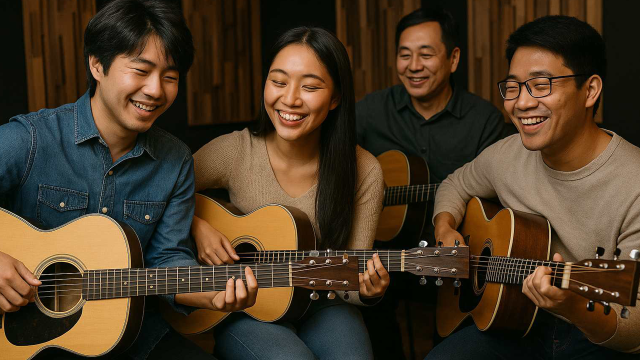How Group Music Lessons Help Students Achieve Better Results Than Private Lessons?

When it comes to learning music, many people believe that one-on-one lessons (private lessons) are the best way to make progress.
But is that really true?
Before choosing a learning format, it’s worth taking a closer look at some common assumptions.
Let’s begin by debunking two widespread beliefs about how music should be taught.
- First False Belief: “I’ll Get Less Attention in a Group, So I Won’t Progress as Fast.”
Many people assume that private, one-on-one lessons are better because the teacher can give them more attention. And yes — it’s true that in a group setting, each student gets less individual attention compared to a private lesson.
But here’s where the false assumption comes in:
More attention from the teacher doesn’t always mean better results.
If that were true, then people training to become surgeons, airline pilots, Marines, or police officers would all be learning through private, one-on-one instruction. But they don’t — and for a good reason. These are high-stakes fields where lives are on the line, and yet the most effective way to train is still in groups.
Let’s take an example from everyday life: the gym.
The coach shows the group how to do an exercise, and then the trainees spend a few minutes practicing on their own. After that, the coach checks their form, gives feedback, and maybe corrects them. Then the trainees keep practicing. It’s a cycle of doing, observing, and correcting.
It’s the same in music lessons — even in one-on-one formats. The teacher doesn’t talk the entire time. Instead, they give the student something to work on, wait while the student tries, and then give feedback or corrections.
This is exactly how group lessons can be effective too.
While one student is practicing, the teacher can check on another — just like a coach at the gym moving between trainees.
- Second False Belief: “We Can’t Group Students Because They’re at Different Levels.”
This is another common misunderstanding. The truth is, mixed-level group learning can work very well — as long as the teacher uses the right approach.
The key is to teach one topic to the whole group, but layer the assignments so that each student is challenged at their own level.
Let’s say we’re learning a song. Here’s how the layers might work:
- Beginners might play just the melody on the high E string.
- Intermediate students could play two-note harmonies or simple chords.
- More advanced students could add chord inversions or more complex voicings.
Another example: we’re working on rhythm.
- Some students may strum using a single note.
- Others might play full power chords or triads.
- More advanced students can explore 7th chords or different chord inversions (first, second, even third inversion).
Everyone is working on the same core skill — but at a level that matches where they are.
This kind of approach keeps things challenging, flexible, and fun for everyone.
The Real Benefits of Learning Music in a Group
Now that we’ve cleared up the common misconceptions, let’s look at the real benefits of group music lessons.
- Music is meant to be shared — not played alone.
Guitar, like most instruments, is often played with others — in a band, a duo, or even just with friends.
Learning in a group setting gives students a chance to practice performing in front of others, just like they eventually will in real life.
Of course, some people feel too shy to join a group. They worry about not being good enough or about others hearing their mistakes.
But here’s what I always tell my students:
- In my class, respect is the rule. No one is ever judged or laughed at.
- And if you’re shy — imagine the moment when you finally play confidently in front of others… and they cheer you on. How do you feel? You just feel great!
Playing in a group helps students overcome shyness better than anything else. After 6 months, a year, or two years of group practice, students gain the confidence to play in front of others — not just in class, but at family gatherings, school events, or open mics.
Now imagine the opposite:
If you only learn in a one-on-one format, what happens the day your family says, “You’ve been learning guitar for a year — play something for Grandpa’s birthday!”
You might freeze, even if you know the song. It doesn’t have to be that way.
- Group Lessons Teach You How to Play With Others
One of the most important — and often overlooked — benefits of group music lessons is that they teach you how to actually play music with other people.
Skills like rhythm and improvisation are essential to becoming a well-rounded musician, and they’re best developed in a group format. When you’re learning with others, you develop a stronger sense of timing, listening, and musical awareness. You begin to understand how to fit your part into the whole, just like in a real band or ensemble.
Many students who learn in a one-on-one format for years are surprised to find that they struggle when asked to play with others. That’s not their fault! That is just because they did not have the chance to play music with others. Unfortunately, many teachers focus only on solo performance, believing that private lessons are the best and only way.
When I was learning the clarinet, we always played in groups. That’s where I learned how to listen closely, play in time, and match the dynamics of the group. Group lessons build those real-world musical skills that private lessons simply can’t replicate on their own.
